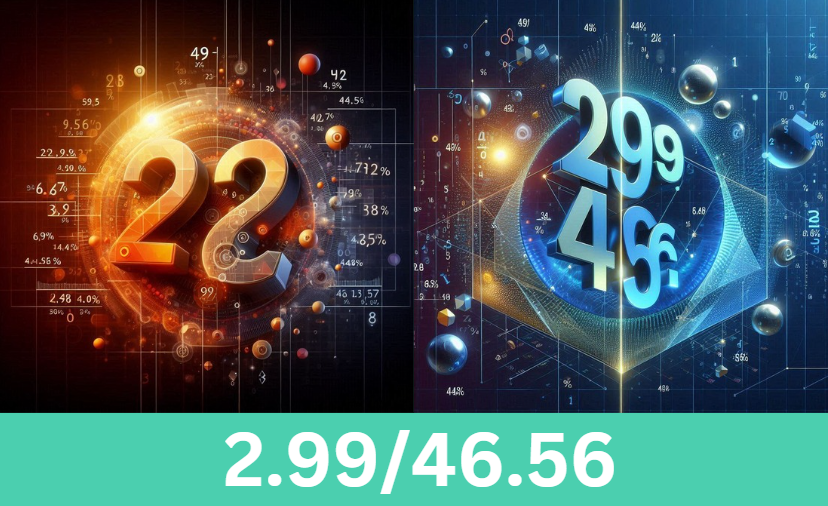Have you ever wondered about the meaning and significance of the fraction 2.99/46.56? While at first glance, it may seem like a random mathematical expression, this ratio holds deeper value in contexts such as mathematics, finance, and real-life applications.
In this guide, we will break down 2.99/46.56 into its simplest form, explain its implications, and explore how it applies to various scenarios. Whether you are a student, a professional, or simply curious, this comprehensive explanation is designed to help you understand and utilize 2.99/46.56 effectively.
Breaking Down 2.99/46.56

Numerator and Denominator Explained
In the fraction 2.99/46.56, the number 2.99 is the numerator, and 46.56 is the denominator. Together, they form a ratio, which compares two values. The numerator represents a part, while the denominator signifies the whole or reference value. For instance, if you were dividing a cake into 46.56 equal parts, 2.99 would represent the portion you are focusing on.
Step-by-Step Calculation

This means that 2.99/46.56 equals approximately 0.0642 or 6.42% when expressed as a percentage.
Applications of 2.99/46.56
Financial Applications
Ratios like 2.99/46.56 are often used to determine proportions in financial contexts. For example, this ratio could represent a percentage of a total investment, a tax calculation, or a discount on a product. Knowing how to interpret such fractions is crucial for budgeting and financial planning.
Educational Contexts
Understanding fractions like 2.99/46.56 is fundamental in mathematics education. Students encounter such ratios when learning about percentages, proportions, and statistical analysis. Using this fraction in classroom examples can demonstrate real-world relevance.
Business Analysis
Businesses frequently work with ratios to analyze data. For instance, if 2.99 products were sold out of 46.56 units in inventory, understanding this ratio helps managers gauge sales performance and inventory turnover rates.
Understanding Ratios in Depth

Definition of a Ratio
A ratio is a comparison between two numbers, often expressed as a fraction, a decimal, or a percentage. In the case of 2.99/46.56, the ratio compares 2.99 to 46.56. This is a foundational concept in mathematics and its related fields.
Importance of Ratios
Ratios are everywhere—in recipes, sports statistics, and even digital marketing. For example, a marketer might calculate conversion rates using a similar ratio format. This makes understanding ratios like 2.99/46.56 practical and relevant.
Real-Life Scenarios of 2.99/46.56
Case Study: Grocery Discounts
Imagine you’re at the grocery store, and a product priced at $46.56 is on sale for $2.99 off. The ratio 2.99/46.56 tells you that the discount is approximately 6.42%. This knowledge can help you decide whether the deal is worth it.
Example from Education
In a test with a total score of 46.56, a student who scores 2.99 would achieve approximately 6.42%. Teachers can use such ratios to explain grading systems and percentages.
How to Calculate Ratios Like 2.99/46.56

Manual Calculation Steps
- Write the ratio as a fraction: 2.99/46.56.
- Divide the numerator by the denominator.
- Simplify the result if possible.
Using a Calculator
Input 2.99 ÷ 46.56 directly into a calculator to get the result quickly and accurately.
Online Tools
There are numerous online ratio calculators available to compute complex fractions like 2.99/46.56 effortlessly.
FAQs About 2.99/46.56
- Is 2.99/46.56 considered a small ratio?
Yes, 2.99/46.56 is a small ratio because the numerator (2.99) is significantly smaller than the denominator (46.56). This means the part represented by 2.99 is a small fraction of the whole value of 46.56. - Can 2.99/46.56 be simplified further?
No, the fraction 2.99/46.56 cannot be simplified further into smaller integers because 2.99 and 46.56 do not share common factors when expressed in their simplest forms. However, the decimal result or percentage is a simplified representation. - What are some alternative ways to visualize 2.99/46.56?
You can visualize 2.99/46.56 using a pie chart or a bar graph. For example, imagine a chart where the entire value of 46.56 is represented as a whole circle, and 2.99 is a small slice showing the proportion. - How does 2.99/46.56 relate to probability?
In probability, ratios like 2.99/46.56 can represent the likelihood of an event happening compared to a total number of possibilities. For example, if 2.99 outcomes are favorable out of 46.56 possibilities, this fraction indicates the probability of the event. - What are some practical fields where such ratios are frequently used?
Ratios like 2.99/46.56 are commonly used in statistics for data analysis, in engineering for efficiency calculations, and in health sciences to determine proportions in dosage measurements or study results. Each field uses such ratios to draw meaningful insights from data.
Conclusion
In summary, 2.99/46.56 is more than just a mathematical fraction. It represents a concept applicable to various fields, from finance to education and beyond. By understanding and interpreting this ratio, you gain a valuable skill that helps in everyday decision-making and problem-solving.
Whether calculating discounts, analyzing data, or teaching mathematical concepts, mastering fractions like 2.99/46.56 is both practical and rewarding.
Make sure to practice with similar examples to solidify your understanding and apply this knowledge confidently in real-life situations!
Affiliated Posts Like 2.99/46.56
MTBB Subtitles for Mushoku Tensei Season 2: The Ultimate Guide
How Many Cups in 2.2 Pounds of Refractory Cement? A Comprehensive Guide



